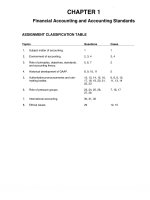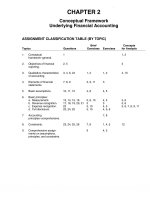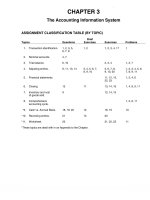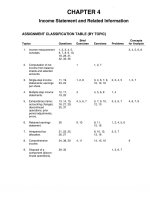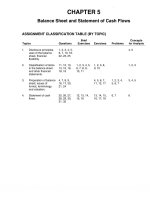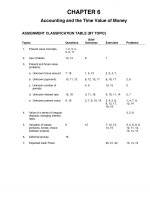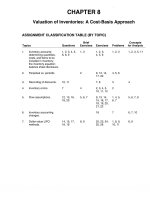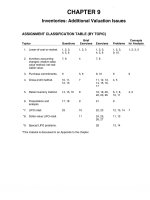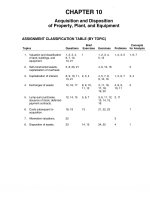Solution manual intermediate accounting 14e kieso weygandt warfield ch02
Bạn đang xem bản rút gọn của tài liệu. Xem và tải ngay bản đầy đủ của tài liệu tại đây (532.66 KB, 47 trang )
CHAPTER 2: BUSINESS ETHICS AND SOCIAL
RESPONSIBILITY
Chapter Overview
Many firms are concerned about the environment and their societies.
Sometimes that means growing more slowly or reducing short-term profits
for longer, sustained benefits. Although most organizations combine ethical
behavior with profitable operation, some have faced ethical lapses. Ethical
failures led to lawsuits and judgments against firms. The image of the CEO
suffered amid reports of executives pocketing millions of dollars.
Now, both the government and companies have renewed their efforts to
conduct themselves in an ethical manner. Firms began to formulate
standards and procedures for ethical behavior and recognize the impact of
setting a good example.
While the aim of business is to serve customers at a profit, companies
today try to give back to customers, society, and the environment.
Sometimes they face difficult questions. When does self-interest conflict
with society’s and customers’ well-being? And must profit-seeking conflict
with right and wrong?
Glossary of Key Terms
Boycott: effort to prevent people from purchasing a firm’s goods or
services.
Business ethics: standards of conduct and moral values involving right
and wrong actions arising in the work environment.
Code of conduct: formal statement that defines how the organization
expects employees to resolve ethical issues.
Conflict of interest: situation in which an employee must make a
decision about a business’s welfare versus personal gain.
Consumerism: public demand that a business consider the wants and
needs of its customers in making decisions.
Corporate philanthropy: act of an organization making a contribution to
the communities in which it earns profits.
41
Discrimination: biased treatment of a job candidate or employee.
Equal Employment Opportunity Commission (EEOC): government
agency created to increase job opportunities for women and minorities
and to help end discrimination based on race, color, religion, disability,
gender, or national origin in any personnel action.
Family leave: granting up to 12 weeks of unpaid leave annually for
employees who have or adopt a child, are becoming foster parents, are
caring for a seriously ill relative or spouse, or are themselves seriously
ill.
Green marketing: marketing strategy that promotes
environmentally safe products and production methods.
Integrity: adhering to deeply felt ethical principles in business
situations.
Pollution: environmental damage caused by a company’s products or
operating processes.
Product liability: responsibility of manufacturers for injuries and
damages caused by their products.
Recycling: reprocessing of used materials for reuse.
Sarbanes-Oxley Act: federal legislation designed to deter and punish
corporate and accounting fraud and corruption and to protect the interests
of workers and shareholders through enhanced financial disclosures,
criminal penalties on CEOs and CFOs who defraud investors, safeguards for
whistle-blowers, and establishment of a new regulatory body for public
accounting firms.
Sexism: discrimination against members of either sex, but primarily
affecting women.
Sexual harassment: unwelcome and inappropriate actions of a sexual
nature in the workplace.
Social audit: formal procedure that identifies and evaluates all
company activities that relate to social issues such as conservation,
employment practices, environmental protection, and philanthropy.
Social responsibility: business’s consideration of society’s well-being and
consumer satisfaction, in addition to profits.
42
Stakeholders: customers, investors, employees, and public affected by or
with an interest in a company.
Whistle-blowing: employee’s disclosure to company officials,
government authorities, or the media of illegal, immoral, or unethical
practices committed by an organization.
Learning Goal 1: Explain the concepts of business
ethics and social responsibility.
Annotated Lecture Outline
Notes:______________________________________________________
_____________________________________________________________
_____________________________________________________________
_____________________________________________________________
_____________________________________________________________
_____________________________________________________________
_____________________________________________________________
_____________________________________________________________
_____________________________________________________________
_____________________________________________________________
_____________________________________________________________
_____________________________________________________________
_____________________________________________________________
_
Opening Vignette: Wal-Mart: Big Retail Goes
Green
Wal-Mart plans to achieve sustainability—a way of
conducting business that reduces its environmental
impact. Wal-Mart built experimental stores that use
innovative technologies to reduce waste and energy
use. Wal-Mart sold 100 million compact fluorescent
light bulbs----a considerable energy savings over
traditional incandescent bulbs. Yet, sustainability
does not mean that Wal-Mart is veering away from
profits.
43
Lecture enhancer:
Describe the benefits
to the environment,
society, and WalMart.
CONCERN FOR ETHICAL AND SOCIETAL ISSUES
1.
Business ethics
a. Business ethics are the standards of
conduct and moral values governing
actions and decisions in the work
environment.
b. How will a decision affect the
environment? customers? employees?
c. These issues are part of social
responsibility—businesses’
consideration of society’s well-being and
consumer satisfaction, in addition to
profits.
d. Businesses must balance between doing
what is right and doing what is
profitable.
2.
Business ethics in practice
a. In business, deciding what is right or
wrong is not clear cut.
b.
A company has responsibilities to:
i.
ii.
consumers, employees, investors
society
c.
Conflicts can arise in serving each
group.
d.
Business ethics are shaped by:
i.
weighing right and wrong before
taking action.
ii.
the ethical climate—a company’s
stated beliefs and real actions.
iii. a code of conduct, a formal
statement that defines how the
44
PowerPoint Slide 3
organization expects employees to
resolve ethical issues.
iv. a framework to encourage high
ethical standards from workers.
Answers to Assessment Check
1. To whom do businesses have responsibilities? Customers,
employees, investors, and society.
2. If a firm is meeting its responsibilities to others, why do ethical
conflicts arise? Ethical conflicts arise because business must balance
doing what is right and doing what is profitable.
Learning Goal 2: Describe the factors that influence
business ethics.
Notes:______________________________________________________
_____________________________________________________________
_____________________________________________________________
_____________________________________________________________
_____________________________________________________________
_____________________________________________________________
_____________________________________________________________
_____________________________________________________________
_____________________________________________________________
_____________________________________________________________
_____________________________________________________________
_____________________________________________________________
_____________________________________________________________
_
THE CONTEMPORARY ETHICAL ENVIRONMENT
1. The ethical environment
a. Business ethics are in the spotlight as
companies have to work harder to earn
45
PowerPoint Slide 4
public trust.
b. In a survey, 95 percent of CEOs replied
that society has greater expectations of
business than it did five years ago.
i. Most managers have led
companies without breaking the
rules; some have documents that
state the company’s beliefs.
Lecture enhancer:
To what four groups
is this firm
responsible?
Which group was
mentioned first?
Last?
How does this order
strengthen the
message in the
credo?
ii. Retailer Target says that its “DNA”
is its commitment to the
community and the environment.
c.
Not all firms meet ethical standards.
i.
The National Business Ethics
Survey found that over half the
employees surveyed “witnessed an
act of misconduct in the past
year.”
ii. The survey found that employees
often did not report misconduct.
2. New government regulations
a.
Sarbanes-Oxley Act
i. The Sarbanes-Oxley Act of
2002 establishes new
regulations for securities
trading and accounting
practices.
46
ii. Companies must publish their
code of ethics and inform
public of changes.
iii. It may encourage companies
to write codes and guidelines.
b. U.S. Sentencing Commission
i. The U.S. Sentencing Commission
institutionalizes ethics compliance
programs and sets high ethical
standards for corporate conduct.
Lecture enhancer:
Name a company in
the news for not
following these steps.
How about a
company that has
followed them in a
newsworthy way?
3.
How companies regulate themselves
c. Ethics compliance officers:
i. monitor conflicts of interest.
ii. deter wrongdoing.
iii. train employees to spot fraud.
iv. investigate sexual harassment and
discrimination.
d.
Many companies have a 3-pronged
approach to addressing ethics and social
responsibility.
i. engage in corporate philanthropy
ii. anticipate and manage risks
iii. identify opportunities to create
value by doing the right thing
4.
Individuals Make a Difference
47
PowerPoint Slide 5
b.
Individuals can affect ethical
expectations and behavior.
c.
Some workers act illegally or
unethically on the job.
i.
The National Business Ethics
Survey identifies behaviors such
as lying, misreporting hours, and
Internet abuse.
ii. Nearly every employee wrestles
with ethical questions.
c.
Technology expands the range and
impact of unethical behavior.
i. Computers allow anyone with
access to steal data or shut down a
system.
d. Employees face ethical questions and
rationalize questionable behavior by
believing that “everyone does it.”
i. Some act unethically when forced
to meet performance quotas.
ii. Others avoid actions that conflict
with personal values and morals.
Answers to Assessment Check
1. What role can an ethics compliance officer play in a firm? To deter
wrongdoing and ensure that ethical standards are met.
2. What factors influence the ethical environment of a business?
Individual ethics and technology.
Learning Goal 3: List the stages in the development
of ethical standards.
48
Notes:______________________________________________________
_____________________________________________________________
_____________________________________________________________
_____________________________________________________________
_____________________________________________________________
_____________________________________________________________
_____________________________________________________________
_____________________________________________________________
_____________________________________________________________
_____________________________________________________________
_____________________________________________________________
_____________________________________________________________
_____________________________________________________________
_
1. Development of individual ethics
PowerPoint Slide 6
Lecture enhancer:
Ask for an example of
an employee whose
actions reflected one
of the three stages of
moral development
a. People develop ethical standards
through three steps: preconventional,
conventional, and postconventional.
b.
In the preconventional stage:
i. They consider their own needs and
desires when making decisions.
ii.
d.
They obey external rules due
to fear of punishment or hope for
rewards.
In the conventional stage:
i.
They respond based on their
duty to others, including family, coworkers, and organizations.
49
ii.
iii.
They decide what is
acceptable based on the influence
of these groups.
Self-interest plays a key role.
e. In the postconventional stage:
i.
They move beyond selfinterest by thinking of the needs of
society.
ii.
They rely on ethical principles
to decide what is right and to take
action.
Business Etiquette:
“The Do’s and Don’ts
of Donating at Work”
When should you
agree to donate?
When should you say
no?
2.
A person’s stage in ethical development
is affected by:
a. Experience.
b. Family, educational, cultural and
religious background.
c. Environment within the company.
Answers to Assessment Check
1. What is the preconventional stage in the development of ethical
standards? The individual looks out for his or her own interests and
follows rules out of fear of punishment or hope of reward.
2. What is the difference between the conventional and the
postconventional stages? Conventional stage: the person considers the
interests and expectations of others; Postconventional stage: the
person considers personal, group, and societal interests.
Learning Goal 4: Identify common ethical dilemmas in
the workplace.
50
Notes:______________________________________________________
_____________________________________________________________
_____________________________________________________________
_____________________________________________________________
_____________________________________________________________
_____________________________________________________________
_____________________________________________________________
_____________________________________________________________
_____________________________________________________________
_____________________________________________________________
_____________________________________________________________
_____________________________________________________________
_____________________________________________________________
_
1.
On-the-job ethical dilemmas
a. Workplace decisions affect an
individual’s future as well as other
workers, managers, and the company.
b. Some CEOs accused of wrongdoing claim
they didn’t know crimes were being
committed.
c. Manufacturers with overseas factories
face ethics issues and criticism for poor
working conditions.
i. Pulling work results in overseas
workers losing jobs.
ii. Improving working conditions
abroad is better.
iii. Some firms have boycotted
(refused to do business with)
nations known for human rights
abuses.
d. Four common ethical challenges: conflict
of interest, honesty and integrity, loyalty
versus truth, and whistle-blowing
51
PowerPoint Slide 7
Lecture enhancer:
Ask for examples
from the news of
employees who have
faced one of these
ethical challenges.
2.
Conflict of interest
a. A conflict of interest exists when a
situation arises in which an action
benefiting one person or group has the
potential to harm another.
i. A person’s interests might conflict
with those of someone to whom
the person has an obligation.
ii. A person may do business with two
parties with opposing interests; a
strategy that helps one might hurt
the other.
iii. Individual interests might clash
with those of an organization or its
customers, including the receipt of
gifts or bribes.
b. Handling conflicts of interest include:
i. Avoiding them
ii. Disclosing them
3.
Honesty and integrity
a. Employers value honesty and integrity.
i. An employee who is honest can be
expected to tell the truth.
ii. An employee with integrity goes
beyond truthfulness by sticking to
deeply felt ethical principles and
acting on them.
iii. Integrity means doing what you
say you’ll do and taking
52
responsibility for mistakes.
b. Honesty and integrity inspire trust
i. This helps build relationships with
customers, suppliers, employers,
and the public.
ii. Employees want companies to
treat them with honesty and
integrity.
c. Workplace violations of honesty and
integrity are common.
i. People misrepresent academic
credentials and previous work
experience on resumes.
ii. Some take home office supplies or
products without permission.
iii. Many do personal business at
work.
d. Electronic monitoring allows firms to
monitor excessive or illicit Internet use
and to keep client data secure.
4.
Loyalty versus truth
a. Businesses expect employees to be loyal
and to act in the best interests of the
company.
b. When the truth about a firm is not
favorable, ethical conflicts arise.
i. Individuals have to decide between
loyalty to the company and
truthfulness.
ii. Some value loyalty at the expense
of truth.
iii. Others value the truth and disclose
negative information about health
53
or safety issues.
5.
Whistle-blowing
a. Whistle-blowing occurs when an
employee tells company officials,
government authorities, or the media of
illegal, immoral, or unethical practices
within an organization.
b. The firm may resolve issues if high-level
managers cooperate.
c. Whistle-blowing may be the only option
when:
i. unethical behavior is causing
significant damage.
ii. potential damage to others
outweighs the risk of retaliation.
d. The risks can be real, as whistle-blowers
have been fired, threatened, and
harassed.
e. Laws protect whistle-blowers.
i. The Sarbanes-Oxley Act requires
that firms provide ways to
anonymously report accusations of
fraud.
ii. Anyone who retaliates against a
whistle-blower can be prosecuted.
iii. Those who are wrongly treated can
file a complaint with the U.S.
Department of Labor.
Answers to Assessment Check
1. What are honesty and integrity, and how do they differ? Honesty is
the trait of telling the truth; integrity goes beyond truthfulness and
means adhering to deeply felt ethical principles.
54
2. How can loyalty and truth come into conflict for an employee?
When the truth about a company or situation is unfavorable.
Learning Goal 5: Discuss how organizations shape
ethical conduct.
Notes:______________________________________________________
_____________________________________________________________
_____________________________________________________________
_____________________________________________________________
_____________________________________________________________
_____________________________________________________________
_____________________________________________________________
_____________________________________________________________
_____________________________________________________________
_____________________________________________________________
_____________________________________________________________
_____________________________________________________________
_____________________________________________________________
_
HOW ORGANIZATIONS SHAPE ETHICAL CONDUCTPowerPoint Slide 8
1. Shaping ethical conduct
a. Organizational standards and beliefs
influence individual choices.
b. Most lapses reflect the values of a firm’s
corporate culture.
c. An ethical corporate culture has four
levels: ethical awareness, ethical
reasoning, ethical action, and ethical
leadership.
55
Lecture enhancer:
Notice which element
is on the bottom and
is the largest, and
which is on the top,
and smallest. Why?
2.
Ethical awareness
a. The foundation of an ethical climate is
ethical awareness.
b. A code of conduct is a formal statement
that defines how the firm expects its
workers to resolve ethical questions.
PowerPoint Slide 9
i. It may specify rules for acceptable
behavior.
ii. It may identify key corporate
values and state how to address
moral and ethical issues.
iii. Some firms incorporate codes in
their policy manuals or mission
statements.
3.
Ethical education
PowerPoint Slide 10
c. Some firms run ethics training programs.
i. Workers practice using ethical
values in hypothetical scenarios.
ii. They can then apply the training to
real-world situations.
4.
Ethical action
PowerPoint Slide 11
a.
Firms provide structures that show
how to turn decisions into actions.
b.
Goals set for the organization,
departments, or individuals affect ethical
behavior.
i.
ii.
Unrealistic goals may lead
to questionable behavior.
The value of speed
creates a climate that prevents
careful thought and challenges ethical
behavior.
56
c.
Companies can support employees
facing moral dilemmas by offering a
hotline.
d.
Ethics compliance officers can help
workers.
5. Ethical leadership
PowerPoint Slide 12
a.
Executives must demonstrate
ethical behavior in their actions.
b.
Firms need to charge each
employee with the responsibility to be
an ethical leader.
c.
All workers should be made
aware of problems and defend
company standards.
d.
Not all organizations build a
framework of business ethics.
i.
Damage from misconduct
affects stakeholders—customers,
investors, employees, and the
public.
ii.
Legislation regulates
businesses that fail to regulate
themselves.
iii.
Laws focus on international
business, small business, labor
unions, banking and securities.
Answers to Assessment Check
1. What is a code of conduct? A formal statement defining the way
the organization expects and requires employees to resolve ethical
questions that arise at work.
2. How does ethical leadership contribute to ethical standards
throughout a company? Employees more readily commit to the
57
company’s core values when they see that 1) leaders and managers
behave ethically, and 2) the ethics program is not a way to protect top
execs from being blamed for wrongdoing.
Learning Goal 6: Describe how businesses’ social
responsibility is measured.
Notes:______________________________________________________
_____________________________________________________________
_____________________________________________________________
_____________________________________________________________
_____________________________________________________________
_____________________________________________________________
_____________________________________________________________
_____________________________________________________________
_____________________________________________________________
_____________________________________________________________
_____________________________________________________________
_____________________________________________________________
_____________________________________________________________
_
ACTING RESPONSIBLY TO SATISFY SOCIETY
1. Social responsibility
a. Social responsibility is management’s
acceptance of the obligation to consider
profit, consumer satisfaction, and
societal well being of equal value when
evaluating the firm’s performance.
i. Firms not only look at profit and
sales.
ii. They are concerned with employee,
consumer, and societal benefits.
b. Business is socially responsible because:
i.
it is required by law
58
PowerPoint Slide 13
ii. it enhances the company’s image
iii. it is ethical
2.
Measuring social responsibility
a.
Historically, firms were measured by
contribution to the economy and
employment opportunities.
b. Today, measurements of social performance
include:
i.
equal employment
ii.
cultural diversity
iii.
environmental
concerns
iv.
safe work
environment
v.
safe, high-quality
products
c. Measurements include interactions with the
community.
i.
Firms highlight charitable
contributions.
ii.
Company Web sites feature
community service.
d. Social audits are formal procedures that
identify and evaluate company activities as
they relate to the following social issues:
PowerPoint Slide 14
Lecture enhancer:
How does one of the
four areas of
responsibility affect
another? Give
examples.
i.
Conservation, the environment,
employment practices, and
59
philanthropy.
ii.
Social audits show how a
company performs and outline
improvements.
e. Outside groups evaluate businesses.
i.
Environmental, religious, or publicinterest groups create standards of
performance.
ii.
They make evaluations available to
the public.
Answers to Assessment Check
1. What is meant by social responsibility and why do firms exercise it?
Management’s acceptance of its obligation to think of profit, consumer
satisfaction, and societal well-being as equal in value when evaluating
the firm’s performance. Firms exercise it because 1) it’s required by
law, 2) it enhances a company’s image, or 3) management believes it’s
ethical to do so.
2. What is a social audit? A formal procedure to identify and evaluate
all company activities that relate to social issues, such as 1)
conservation, 2) employment practices, 3) environmental protection,
and 4) philanthropy.
Learning Goal 7: Summarize the responsibilities of
business to the general public, customers, and
employees.
Notes:______________________________________________________
_____________________________________________________________
_____________________________________________________________
_____________________________________________________________
_____________________________________________________________
_____________________________________________________________
_____________________________________________________________
_____________________________________________________________
_____________________________________________________________
_____________________________________________________________
60
_____________________________________________________________
_____________________________________________________________
___________________________________________________________
1.
Responsibilities to the general public
a. Public-health issues
PowerPoint Slide15
Solving an Ethical
Controversy:
“Wellness at
Work: Big Brother
Butts In”
Lecture enhancer:
Should employers be
permitted to require
employee
participation in
wellness programs?
i. What should businesses do about
public-health issues, including risks
posed by their products?
Case 2.1: Honda’s
FCX Clarity: A Clearer
View of the Future
ii. Health risks from tobacco,
alcohol, and substance abuse,
plus heart disease, diabetes, and
obesity.
b. Protecting the environment
i. The use of coal and oil present
environmental hazards.
Hit or Miss: Is It
Time to Rethink
Nuclear Power?
ii. Resulting sulfuric acid causes
climate change, and acid rain
harms fish, forests, and water.
Lecture enhancer:
iii. Production methods leave behind
waste materials, and some
products contain toxic lead and
61
Should the United
States develop
nuclear energy? Why
or why not?
mercury.
iv. Few firms are equipped to handle
recycled electronic materials.
v. Reducing pollution can be difficult
and expensive.
vi. Recycling, reprocessing used
materials for reuse, fights pollution
and conserves natural resources.
vii. The EPA says 40% of the lead in
landfills is now from electronics or
computer parts.
viii. Green marketing is a strategy that
promotes environmentally safe
products and production methods.
Figure 2.7: FTC
Guidelines for
Environmental Claims
in Green Marketing.
ix. Firms follow FTC guidelines and
provide scientific evidence of
environmental claims.
Lecture enhancer:
x. A growing focus is finding
renewable sources of clean energy
and developing sustainable
agriculture.
Lecture enhancer:
c. Developing the quality of the workforce
i.
ii.
People are a nation’s
true wealth.
An educated, skilled workforce
provides the know-how to develop
technology and compete globally.
iii. The gap between the highest- and
lowest-paid workers has increased.
62
How accurate is the
marketing campaign,
based on the FTC
guidelines?
Have you noticed
green marketing in a
business you use?
iv. Diversity programs allow women,
minorities, and the physically
challenged workers to contribute
fully.
d. Corporate philanthropy
2.
i.
Corporate philanthropy refers to
the donation to not-for-profits of
billions of dollars annually in the
form of cash, free equipment and
products, and employee volunteer
efforts.
ii.
It can boost employee morale,
enhance company image, and
improve customer relationships.
iii.
In cause-related marketing, firms
align advertising with charitable
giving and corporate sponsorships.
Responsibilities to customers
PowerPoint Slide 16
a.
Consumerism is the public demand
that a business consider the wants and
needs of its customers in making
decisions.
Figure 2.8: Consumer
Rights as Proposed by
President Kennedy
b.
Consumerism is based on the belief
that consumers have certain rights.
Case 2.2: Local
Produce: It’s
Good for
Everyone
Lecture enhancer:
Choose one of the
rights and give an
example of its effect
on today’s
marketplace.
c.
The right to be safe
63
i.
Businesses must
ensure that their products operate
safely.
ii.
Product liability
refers to the responsibility of
manufacturers for injuries and
damages caused by their
products.
iii.
A company must
thoroughly test its products.
d. The right to be informed
i.
Consumers should
have access to product information to
make responsible buying decisions.
ii.
Truth in
advertising is protected by rules and
regulations set up by the FTC and
other agencies
iii.
It’s illegal for a
business to mislead consumers or
make false promises.
Figure 2.9: Wacky
Warning Labels
All
communications with customers must
be clear and accurate.
Lecture enhancer:
iv.
e.
The right to choose
i. Consumers have the right to choose
which products they need and want to
purchase
ii. Socially responsible companies preserve
this right, even if it has a negative
impact on sales and profits
f. The right to be heard
64
How do these
examples involve the
right to be informed?
i. Consumers have the right to express
legitimate complaints.
ii. Many companies ensure full hearings for
consumer complaints.
3. Responsibilities to employees
PowerPoint Slide17
a. Businesses are responsible to workers here
and abroad in terms of safety, quality-oflife, and equal opportunity.
b.
They must avoid age
discrimination, sexism, and sexual
harassment.
c. Workplace safety
d.
i.
A century ago,
workplace safety was of little concern.
ii.
OSHA (Occupational
Safety and Health Administration) was
established to set workplace safety and
health standards.
iii.
It creates rules for
specific industries, tracks workplace
accidents, and protects teen workers.
Quality-of-life issues
i.
Balancing work and family is hard.
ii. Working mothers, single parents, or those
in the sandwich generation, who care for
young children and elderly parents,
stretch their time.
iii. Firms offer flexible hours and family
leave, time off to deal with family
matters.
65
Hit & Miss:
Employers Examine
Sick Time
